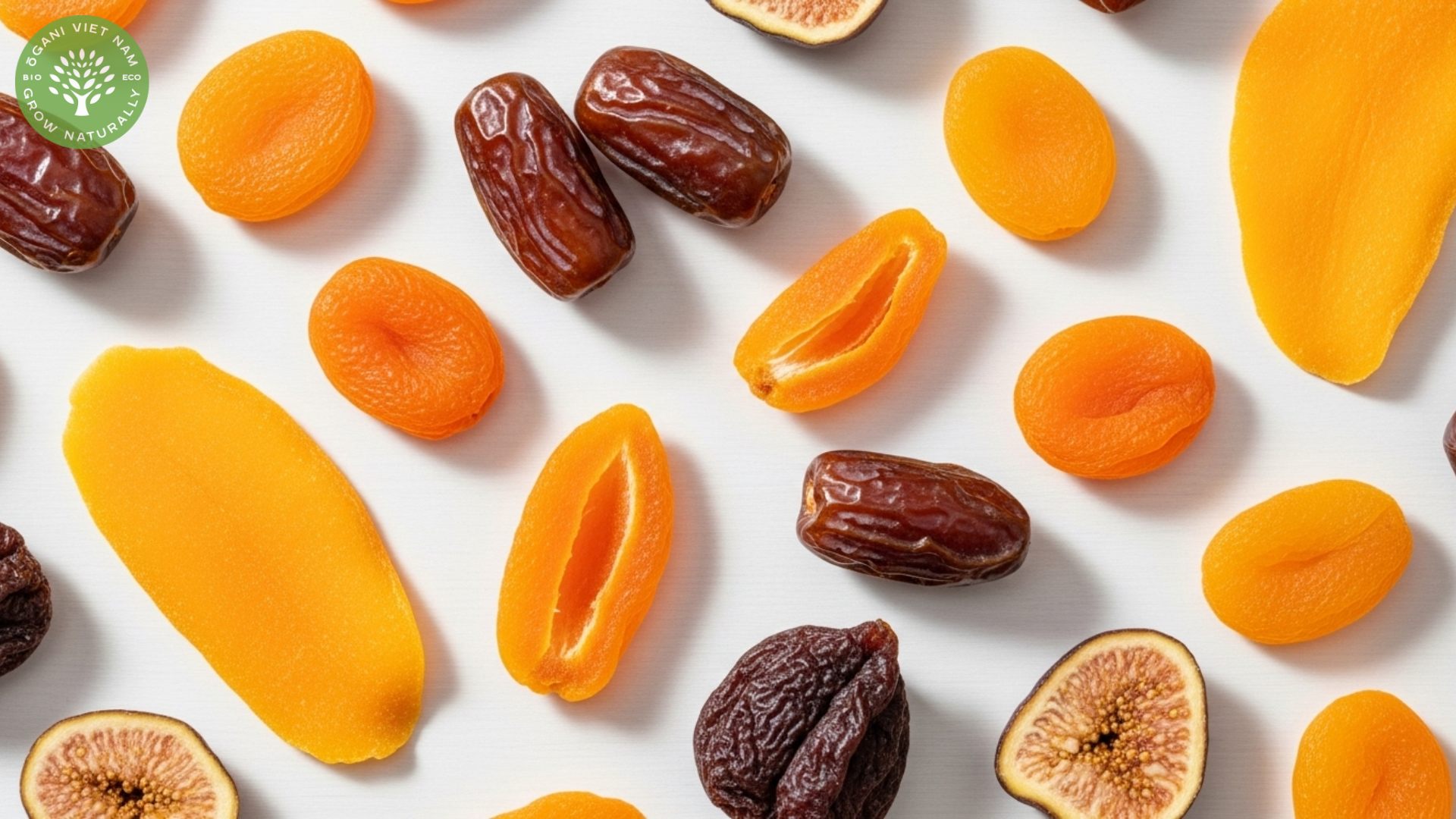
What is soft dried fruit?
Soft dried fruit is like a little taste of sunshine — fruit that’s been slowly dried at a gentle temperature so it stays soft, chewy, and full of natural sweetness. With just enough moisture (about 15–20%) to keep it tender, it keeps much of the fruit’s original flavor, color, and nutrients. Think of it as the happy middle ground between fresh fruit and the usual dried kind — sweet, satisfying, and naturally good for you.
What is soft dried fruit and why does it matter?
What is soft dried fruit?
It’s a question we often hear at Ogani VN — and honestly, we understand why. Many people think it’s just another version of dried fruit, but the truth is, there’s a quiet art behind it.
Soft dried fruit is made with patience. Instead of blasting the fruit with heat until it’s hard and brittle, we let it dry slowly, gently — at a low temperature that keeps its soul intact. As the water leaves, the natural sweetness stays, wrapping itself around every bite. The fruit becomes tender, chewy, and full of life — like sunshine preserved in a soft, golden slice.
It’s more than just a snack. It’s fruit cared for with time, warmth, and respect — so when you taste it, you can still feel a bit of the orchard in every bite.
The soft drying process and technology
The secret to soft dried fruit is really quite simple — it’s all in the way we treat the fruit. We don’t rush it or drown it in heat. Instead, we let it dry slowly, gently, at just the right warmth — around 60 to 70°C. At that temperature, the fruit seems to breathe, losing water little by little while keeping its sweetness, color, and tender heart. What comes out isn’t just dried fruit — it’s fruit that’s been cared for, patiently, until it’s soft, golden, and full of quiet flavor.
How the process works
The making of soft dried fruit always begins with a quiet kind of respect — for the fruit itself. Only the ripest, most vibrant ones are chosen, the kind that already taste like sunshine. They’re then placed in a gentle, carefully watched space where warmth, air, and time move in harmony.
Unlike sun-drying, which leaves fruit at the mercy of weather and dust, this process feels more like a slow conversation between nature and care. The moisture isn’t pulled out all at once; it’s released little by little — just enough to keep the fruit safe, but not enough to take away its soul.
What’s left is something soft, sweet, and alive — fruit that still remembers where it came from.
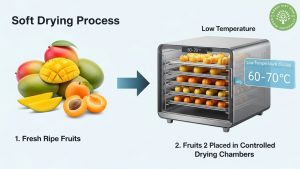
That lovely chewiness you get from soft dried fruit comes from the little bit of moisture that’s still there — just around 15 to 20%. It’s what keeps the fruit soft and a bit juicy, not dry or tough. Almost like it’s holding on to a touch of its fresh, sun-kissed self.
Equipment and technology
To make soft dried fruit, most producers don’t just use ordinary dehydrators. They rely on gentle, carefully tuned machines — the kind that can watch over every breath of warmth and air as the fruit slowly dries. It’s less about technology and more about patience — giving the fruit the perfect space to rest, to lose its water little by little, and to keep its sweetness and softness just right.
What is soft dried fruit vs regular dried fruit – the key differences
Here’s where it gets a bit more interesting — and where people often get confused. The difference between regular dried fruit and soft dried fruit isn’t just about how they look, but how they feel.
Texture and mouthfeel:
Regular dried fruit is usually dry and crunchy — like banana chips that snap or raisins that feel a little leathery. Soft dried fruit is different. It’s tender, a little bouncy, and has that pleasant chew that feels close to fresh fruit. When you bite into it, there’s a softness, a quiet sweetness — like the fruit still remembers what it was before it dried.
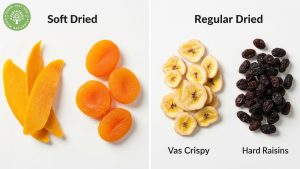
When you bite into a piece of soft dried mango, it doesn’t snap like a chip — it yields gently, almost melting on your tongue, with that mellow sweetness spreading slowly.
Moisture content:
Regular dried fruit has nearly all its water taken away — only about 5–10% left. But soft dried fruit keeps a bit more, around 15–20%, just enough to stay tender and pleasantly chewy. That touch of moisture is what gives it life — soft, bendy, and naturally sweet.
Nutritional preservation:
Because the drying process is slower and gentler, more of the good stuff stays inside. Vitamins that don’t like heat — like vitamin C and some Bs — survive better, so the fruit keeps more of its natural goodness.
Flavor profile:
Soft dried fruit tastes closer to the real thing — light, fragrant, and full of the fruit’s true flavor. Regular dried fruit, in contrast, can taste more intense or caramel-like — still good, just a bit different, like the flavor has grown older and deeper.
Storage and shelf life:
Since soft dried fruit holds more moisture, it won’t last as long as the fully dried kind. But that’s part of its charm — it feels more alive, more fresh, more like something that came from nature, not just a packet on a shelf.
Health benefits and nutritional content
We often get asked whether soft dried fruit is healthy, and the answer is nuanced.
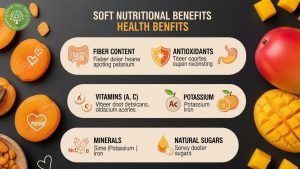
Just like other dried fruits, soft dried fruit is full of goodness — vitamins, minerals, fiber — but it also has more natural sugar than fresh fruit. It’s sweet, satisfying, and a little goes a long way.
Fiber content:
Soft dried fruits still hold on to most of their natural fiber, which helps your digestion and keeps your energy steady. A small handful of soft dried apricots gives you around 3 grams of fiber — gentle, filling, and good for your gut.
Antioxidants and vitamins:
Because they’re dried slowly, many of the fruit’s natural nutrients stay intact. You still get the vitamin A from apricots, the vitamin C from tropical fruits, and the rich berry antioxidants that help your body fight off stress and inflammation. It’s like a quiet kind of strength packed inside each soft bite.
Natural sugars:
Here’s the part to keep in mind — all that sweetness is natural, but it’s more concentrated than in fresh fruit. So a few pieces are enough to enjoy the flavor and energy without overdoing the sugar.
Mineral content:
Soft dried fruits are also rich in potassium, iron, and other important minerals. Dates, for example, are loaded with potassium, which helps your heart and muscles work smoothly.
But it’s good to remember — dried fruits, even the soft kind, are dense in energy. A little goes a long way. They’re nature’s candy, after all — sweet, nourishing, and best enjoyed with a bit of care.
Popular varieties and how to choose quality soft dried fruit
At Ogani VN, we’ve seen certain soft dried fruit varieties become customer favorites, and for good reason.
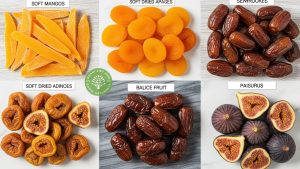
Soft dried mangoes are always the crowd favorite — golden, sweet, and just chewy enough to keep you reaching for one more piece. The best ones still hold that bright, sunny orange of a fresh mango, not too dark, not too dull. That color tells you the fruit was treated gently, not rushed.
Soft dried apricots have their own quiet beauty — soft, tangy, and a little fragrant. When they’re good, they look plump and glowing, like tiny drops of sunset. If they turn brown or too dark, it often means they’ve been overdone or stored too long — and they lose that lively taste.
Dates and figs are naturals at this. With their soft texture and rich sweetness, they hardly need any help. Just a bit of gentle drying, and they become perfectly chewy, with that deep, honeyed flavor that feels comforting and real.
When choosing soft dried fruit, let your senses guide you. The fruit should bend softly but not stick to your fingers, and its color should feel alive — close to how it looked when fresh. If it’s hard, dull, or covered in tiny sugar crystals, it’s probably been sitting too long. The good ones feel honest — tender, fragrant, and quietly full of life.
What is soft dried fruit? Frequently asked questions
Is soft dried fruit healthier than regular dried fruit?
They’re actually quite similar. Both are full of natural goodness — fiber, vitamins, minerals — but soft dried fruit is made with lower heat, so it tends to keep a little more of the delicate vitamins that don’t like high temperatures. The real difference is in the feel and taste — soft dried fruit is gentler, chewier, a bit closer to fresh.
How long does soft dried fruit last?
If you store it somewhere cool and dry, it usually keeps well for about 6 to 12 months. Because it still holds more moisture, it won’t last quite as long as the hard, fully dried kind. But honestly, it’s so tasty and easy to snack on — it rarely lasts that long anyway.
Can I make soft dried fruit at home?
Yes, you can. You’ll just need a dehydrator that lets you control the heat. Set it around 60–70°C and dry the fruit slowly. The trick is to stop before it turns crispy — you want it soft and a little springy when you press it between your fingers.
Which fruits work best for soft drying?
Sweet, juicy ones — like mangoes, apricots, bananas, figs, or dates — turn out beautifully. Even berries can be soft dried, though they need a bit more care because they’re delicate and full of juice.
Is soft dried fruit good for kids?
Definitely, just not too much at once. The chewy texture and gentle sweetness make it a great little treat, but since the sugar’s naturally concentrated, a few pieces are plenty. It’s one of those snacks that feels like candy, but without the guilt.
Now you know what is soft dried fruit – ready to make the switch?
Soft dried fruit is that lovely in-between — not as juicy as fresh fruit, but not dry and tough either. It’s soft, chewy, and naturally sweet, with the taste and color of real fruit still shining through. Because it’s dried slowly at low temperatures, the fruit keeps more of its goodness — the vitamins, the scent, the gentle flavor that feels close to nature.
At Ogani VN, we take our time with every batch. We choose ripe, flavorful fruits and dry them just enough to keep their natural sweetness and softness. No shortcuts, no heavy processing — just simple care and patience.
Whether you like to snack on something light, add a touch of fruit to your breakfast, or sweeten up your baking, our soft dried fruits fit right in. They’re easy to love, easy to keep, and always full of quiet, honest flavor — the kind that reminds you of real fruit, just gently slowed down.
Read more:
- Red Dragon Fruit Powder (Pink Pitaya): Benefits, Uses & Buying Tips
- Pitaya Powder: Complete Guide to Benefits & Uses
- What Is Soft Dried Fruit? Process, Moisture Level & Why It’s Different
- Organic Dried Mango Wholesale: Premium Quality from Ogani VN
- Unsweetened Vs No Sugar Added Vs Low Sugar Dried Mango: What’s The Difference?

